Lallart M. (ed.) Ferroelectrics - Physical Effects
Подождите немного. Документ загружается.

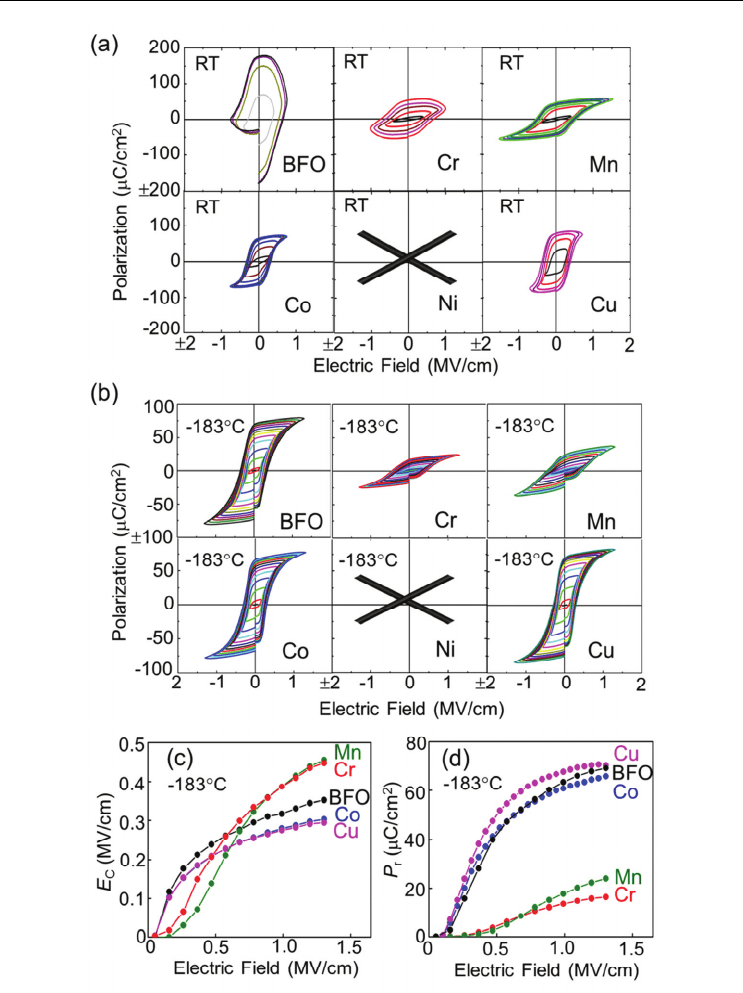
Multifunctional Characteristics of B-site Substituted BiFeO
3
Films
389
Fig. 18. Ferroelectric hysteresis loops of the Bi(M
0.05
Fe
0.95
)O
3
films measured at RT using the
ferroelectric tester with a 100 kHz driving system and measured at -183°C using a 2 kHz
driving system.

Ferroelectrics – Physical Effects
390
MV/cm. Thus, Co and Cu substitution reduced the E
c
of polycrystalline BiFeO
3
films
without reducing P
r
, which is suitable for memory and/or piezoelectric devices.
Figure 19 shows the magnetization curves of the Bi(M
0.04
Fe
0.96
)O
3
films measured at RT. As
mentioned in the previsou section, the pure BiFeO
3
films showed small magnetization.
However, the substitution of Co, Ni, and Cu caused an increase in the magnetization,
indicating substitution of these TM into the B sites of Fe, although it was not clear whether
all the TMs were substituted into the B-sites. In the case of Co-substituted BiFeO
3
, there was
an increase in magnetization accompanied by the appearance of spontaneous magnetization
and the coercive field of 2 kOe was observed at RT. In addition, according to other report,
(Zhang et al., 2010) clear observation of the magnetic domain structure using magnetic force
microscopy (MFM) at RT was observed in 4 at.% Co-substituted BiFeO
3
has been reported.
Based on these results, the increased magnetization in Co-substituted BiFeO
3
was confirmed
by both macroscopic and local measurement methods.
Fig. 19. Magnetization curves of the Bi(M
0.05
Fe
0.95
)O
3
, M= Cr, Mn, Co, Ni, and Cu] films
measured at RT.
Cross-sectional TEM observation was carried out in order to clarify the influence of
magnetic impurities on spontaneous magnetization in Co-substituted BiFeO
3
films.
(Naganuma et al., JMSJ 2009) Co-substituted BiFeO
3
film was deposited on a Pt/Ti/SiO
2
/Si
(100) substrate having a relatively flat surface. Grains of approximately hundreds of nm in
size were formed. [Fig. 20(a)] Obvious secondary phases could not be observed in the wide
area images. Figure 20(b) shows the NBD patterns for the [-1 3 -2] direction of the Co-
substituted BiFeO
3
layer. Analysis of the NBD pattern shows that the crystal symmetry is
rombohedral with a R3c space group, and the lattice parameters are a = 0.55 nm, c = 1.39 nm.
The high-resolution TEM image around the grain boundary is shown in Fig. 20(c). Grain
boundary formation is evident but the grain boundary phases could not be observed in this
film. Therefore, it can be inferred that Co was substituted for Fe in BiFeO
3
, and the
magnetization enhancement might not be attributed to magnetic impurity phases. It was
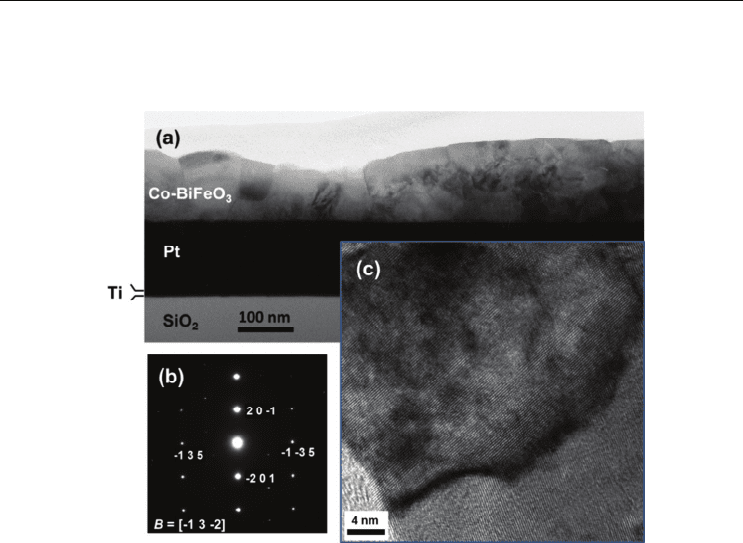
Multifunctional Characteristics of B-site Substituted BiFeO
3
Films
391
concluded that the substitution of small of Co into the B-sites of BiFeO
3
could improve the
leakage current property, reduce the electric coercive field without degrading the remanent
polarization, and induce spontaneous magnetization at RT.
Fig. 20. Cross sectional TEM images of polycrystalline Co-BiFeO
3
film.
4. Multifunctional characteristics of BiCoO
3
-BiFeO
3
solid solution epitaxial
films
As clarified in the third section, the 4 or 5 at.%-Co-substituted BiFeO
3
polycrystalline films
exhibited excellent electrical and magnetic characteristics. Substitution with larger amounts of
Co was expected to result in further enhancement of the electrical and magnetic properties. It
should be noted that high-pressure behavior becomes dominant in the highly Co-substituted
BiFeO
3
films due to the high-pressure phase of BiCoO
3
. In fact, a maximum of approximately 8
at.% Co can be substituted for Fe in the case of polycrystalline films while maintaining a single
phase, whereas secondary phases of BiO
x
are formed at Co concentrations above 8 at.%.
(Naganuma et al., JAP 2008) Because the character of BiCoO
3
is strongly influenced at high Co-
substitution, hereafter, we refer to highly Co-substituted BiFeO
3
films as BiCoO
3
-BiFeO
3
. In
one of our studies, (Naganuma et al., JAP 2009) the high-pressure phase of BiMnO
3
was
successfully stabilized in a thin-film form by using epitaxial strain. In accordance with this
study, solid solution films of BiCoO
3
-BiFeO
3
having a high BiCoO
3
content could also be
stabilized on SrTiO
3
(100) single crystal substrates by epitaxial strain. In this section, the
structural, (Yasui et al., JJAP 2007) ferroelectric, (Yasui et al., JJAP 2008, Yasui et al., JAP 2009)
and magnetic properties (Naganuma et al., JAP 2011) of epitaxial BiCoO
3
-BiFeO
3
films grown
on SrTiO
3
substrates up to a BiCoO
3
concentration of ∼58 at.% are systematically investigated.
The BiFeO
3
–BiCoO
3
solid solution films were grown on SrTiO
3
(100) substrates at 700°C by
metalorganic chemical vapor deposition (MOCVD) established in Funakubo laboratory, and
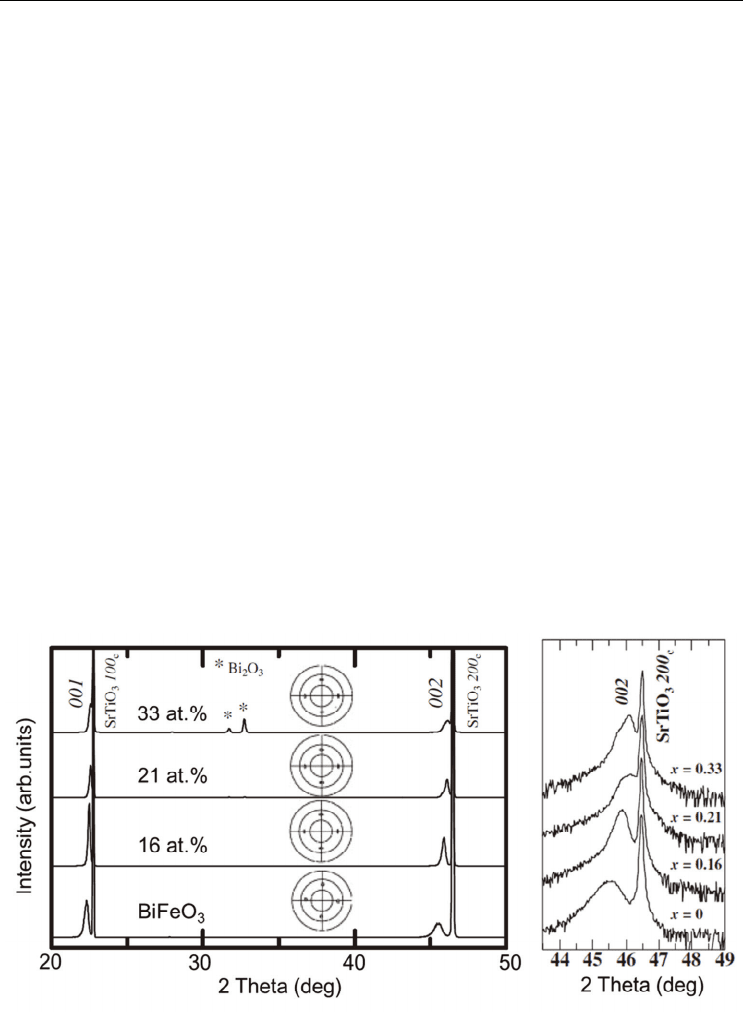
Ferroelectrics – Physical Effects
392
Bi[(CH
3
)
2
-(2–(CH
3
)2NCH
2
C
6
H
4
)], Fe(C
2
H
5
C
5
H
4
)
2
, Co(CH
3
C
5
H
4
)
2
and oxygen gas was used
as the source materials. A vertical glass type reactor maintained at a pressure of 530 Pa was
used for the film preparation. The films were deposited by MOCVD using pulse
introduction of the mixture gases with Bi, Fe, and Co sources (pulse-MOCVD). The
thickness of these films was approximately 200 nm. (Yasui et al., JJAP 2007) The crystal
structure of the deposited films was characterized by high-resolution XRD (HRXRD)
analysis using a four-axis diffractometer (Philips X’-pert MRD). HRXRD reciprocal space
mapping (RSM) around SrTiO
3
004 and 204 was employed for a detailed analysis of crystal
symmetry. The cross-sectional TEM (Hitachi HF-2000) observation working at 200 kV was
used for microstructural analysis. The crystal symmetry was also identified using Raman
spectroscopy by K. Nishida. (Yasui et al., JJAP 2007) Raman spectra were measured using a
subtractive single spectrometer (Renishaw SYSTEM1000) with a backward scattering
configuration. A laser beam was focused on the film surface, and the beam spot was
approximately 1 μm. The measurement time was fixed at 100 s. The leakage current v.s.
electrical field and P-E loops were measured with a semiconductor parameter analyzer
(HP4155B, Hewlett-Packard) and ferroelectric tester (TOYO Corporation, FCE-1A). The
magnetic properties were measured in the in-plane direction using SQUID.
Figure 21 shows the typical θ/2θ and pole-figure HRXRD profiles of BiFeO
3
–BiCoO
3
solid
solution films (BiCoO
3
concentrations of 0, 16, 21, and 33 at.%) grown on SrTiO
3
(100)
substrates. Although Bi
2
O
3
of secondary phase has a tendency to be formed at a high BiCoO
3
concentration, the single phase of BiFeO
3
–BiCoO
3
was successfully obtained by optimizing
preparation conditions. The pole-figure HRXRD profiles indicate that all the films were
epitaxially grown on SrTiO
3
(100) substrates. The magnified θ/2θ XRD profiles around
BiFeO
3
–BiCoO
3
002 indicate that the 002 peak shifted to high angle upon increasing the
BiCoO
3
concentration, which indicates that the lattice constant for the out-of-plane direction
approximated that of the SrTiO
3
substrates at high BiCoO
3
concentration.
Fig. 21. θ/2θ and pole-figure HRXRD profiles of BiFeO
3
–BiCoO
3
solid solution films
(BiCoO
3
concentration of 0, 16, 21, and 33 at.%) grown on SrTiO
3
(100) substrates.

Multifunctional Characteristics of B-site Substituted BiFeO
3
Films
393
The structures of the bulk forms of BiFeO
3
and BiCoO
3
are rombohedral and tetragonal,
respectively. Conventional θ/2θ XRD measurement cannot be used to identify whether the
crystal symmetry is rombohedral or tetragonal in the case of the BiFeO
3
–BiCoO
3
solid
solution films. Therefore, HRXRD-RSM measurements around SrTiO
3
004 and 204 were
employed in the investigation of the crystal symmetry of the films. [Fig. 22] The pure BiFeO
3
film exhibited rhombohedral/monoclinic symmetry, as indicated by the existence of two
asymmetric 204 spots in Fig. 22(b) and only one center spot of 004 in Fig. 22(a). This result is
in agreement with that reported by Saito et al. for epitaxial BiFeO
3
films grown on SrRuO
3
(100)/SrTiO
3
(100) substrates. (Saito et al., JJAP 2006) On the other hand, only single 204 and
004 spots were found for the film with a BiCoO
3
of 33 at.% [Figs. 22(g) and 22(h)], which
indicates tetragonal crystal symmetry. Figures 22(c), 22(d), 22(e), and 22(f) show the
HRXRD-RSM profiles for the films with 16 and 21 at.% BiCoO
3
, respectively. Three peaks
including one parallel spot and two tilting spots with a SrTiO
3
[001] orientation for 204, in
both films, represented the existence of a mixture of (rhombohedral/monoclinic) and
tetragonal symmetries.
Fig. 22. HRXRD-RSM measurements around SrTiO
3
004 and 204.
Raman spectroscopy was carried out in order to precisely check the change in crystal
symmetry by K Nishida. (Yasui et al., JJAP 2007) Raman spectra of the BiFeO
3
-BiCoO
3
films
and that of the SrTiO
3
substrate are shown in Fig. 23. The SrTiO
3
substrate shows a peak at 81
cm
-1
, which is shifted to a value within 75-78 cm
-1
for the films with 0-33 at.% BiCoO
3
. It was
confirmed that the peak observed for the films does not originate from the SrTiO
3
substrate.
The decrease in the intensity of the SrTiO
3
peak with increasing film thickness for pure BiFeO
3
and the disappearance of the peak at ∼600 cm
-1
, as shown in Fig. 23, are also in agreement with
the above results. The typical rhombohedral symmetry observed for bulk BiFeO
3
was
indicated for the pure BiFeO
3
film and 16 at.% BiCoO
3
film. Different patterns with
rhombohedral symmetry were observed for the film with 33 at.% BiCoO
3
, which was shown to
have tetragonal symmetry from the analysis of the HRXRD-RSM data. Furthermore, this peak
of film was very similar to that of BiCoO
3
powder which has been confirmed to have
tetragonal symmetry. For the films with 21 at.% BiCoO
3
, it was ascertained from Fig. 23 that
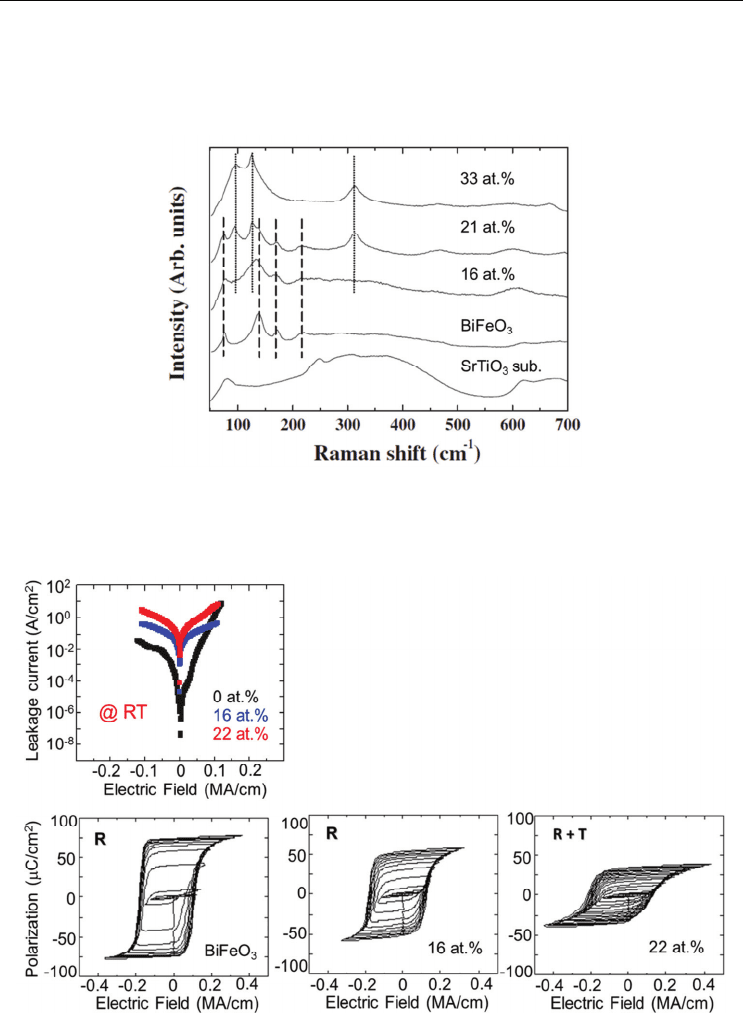
Ferroelectrics – Physical Effects
394
the tetragonal and rhombohedral symmetries coexisted, which is almost consistent with the
findings of the HRXRD-RSM experiment. It was revealed that the phase transition in BiFeO
3
–
BiCoO
3
from (rhombohedral/monoclinic) symmetry to tetragonal symmetry is similar to the
morphotropic phase boundary (MPB) in Pb(Zr
x
Ti
1-x
)O
3
.
Fig. 23. Raman spectra of the BiFeO
3
-BiCoO
3
films and the SrTiO
3
substrate
Figure 24 shows the leakage current v.s. electrical field measurements taken at RT and P-E
hysteresis loops measured at -193°C for the BiFeO
3
-BiCoO
3
films. The leakage current
Fig. 24. Leakage current vs electric field measured at RT and P-E hysteresis loops measured
at -193°C for the BiFeO
3
-BiCoO
3
epitaxial films.

Multifunctional Characteristics of B-site Substituted BiFeO
3
Films
395
density at RT was very large for the BiFeO
3
-BiCoO
3
films with high BiCoO
3
concentration,
and the leakage current density increased with increasing BiCoO
3
concentration. Because of
the magnitude of the leakage current at a BiCoO
3
concentration of 33 at.%, a leakage current
measurement could not be evaluated for this film at RT using the semiconductor parameter
analyzer. Although the previous discussions indicated that a small amount of Co-
substitution can effectively reduce the leakage current, it can be seen from these that a large
amount of Co-substitution degraded the leakage current property. In order to reduce the
influence of leakage current density on the P-E hysteresis measurement for samples having
a high BiCoO
3
concentration, the P-E loops were measured at a low temperature of -193°C.
The P-E loops observed at -193°C were of relatively high squareness and the influence of
leakage current density on the P-E loops could be successfully excluded at this temperature,
except for the BiCoO
3
concentration of 33 at.%. At -193°C, spontaneous polarization
decreased, and the coercive field of BiFeO
3
-BiCoO
3
films increased with increasing BiCoO
3
concentration.
In the case of films with weak ferromagnetism such as BiFeO
3
films on substrates,
eliminating the magnetization of the substrates from the films is important for acurrate
evaluation of the magnetic properties of the films. Therefore, here, the magnetic properties
of SrTiO
3
substrates were carefully evaluated. Figure 25(a) shows the M-H curves for two
different weights of SrTiO
3
substrates. The SrTiO
3
substrates show a negative slope due to
dimagnetism. The magnetization at 50 kOe (M
50kOe
) for various weights of the SrTiO
3
substrates is plotted in Fig. 25(b). The absolute value of magnetization decreases with a
decrease in the substrate weight, but some of the magnetization is retained even at zero
weight. This retained magnetization is considered to be the background caused by the straw
of the sample holder. In this study, standard straws produced by Quantum Design Inc. were
used. Figure 25(c) shows the M-H curves of the SrTiO
3
substrate (weight = 0.0471 g) at 10
and 300 K. The hysteresis was not observed near the zero-field even at 10 K, indicating low
magnetic impurity in the SrTiO
3
substrates and sample holder. The temperature dependence
of M
50kOe
is shown in Fig. 25(d). The diamagnetism slope decreased slightly with the
temperature, however, it was not strongly influenced by the temperature. In this study, the
magnetic properites of the films were carefully evaluated by eliminating SrTiO
3
substrate
magnetization, and the same sample holder was used in all the magnetic measurements to
exculde the effect of differences among straws.
Figure 26 shows the M-H curves measured at 300 K and the corresponding magnetic
parameters that were estimated from the M-H curves. For pure BiFeO
3
, the magnetization
increased linearly at a high magnetic field. [Fig. 26(a)] Small hysteresis was observed near
the zero fields, which is relatively obvious compared with that of polycrystalline BiFeO
3
films. [Fig. 15] For BiCoO
3
concentrations of 18–25 at.%, magnetization was clearly
enhanced, and H
c
was observed. [Figs. 26(b) and 26(c)] For a BiCoO
3
concentration of 58
at.%, the M-H curve was almost identical to that of pure BiFeO
3
films. There is an
apparent linear increase in the magnetization at high-magnetic field for all the specimens.
It was reported that by substituting A-site Bi ions in bulk BiFeO
3
with Gd or Nd,
spontaneous magnetization was observed, and the magnetization increased linearly in the
high-magnetic field region, which is in agreement with our results. Although it is difficult
to accurately evaluate the slope at a high field due to film form, it can be considered that
the antiferromagnetic spin structure still remained after substitution at the A- or B-site.
The magnetic parameters M
50kOe
, remanent magnetization (M
r
), and coercive field (H
c
),
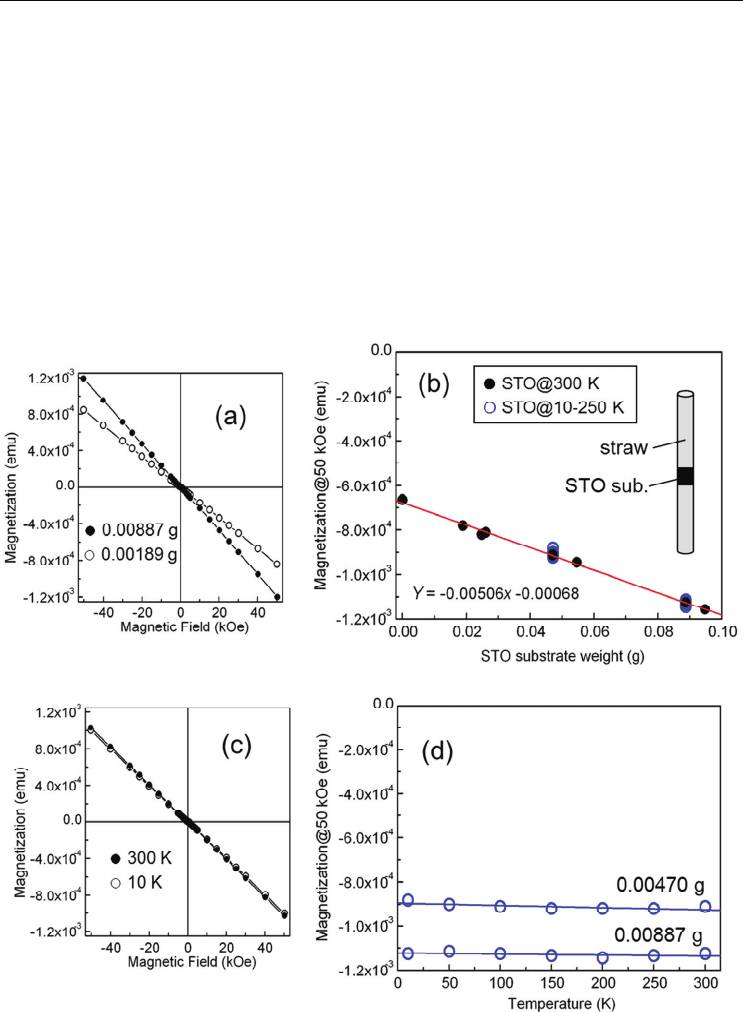
Ferroelectrics – Physical Effects
396
estimated from the M-H curves are shown in Figs. 26(d) - 26(g). M
10kOe
for polycrystalline
BiCoO
3
-BiFeO
3
films is also plotted in Fig. 26(e). The acronyms M
50kOe
and M
10kOe
indicate
the magnetization at 50 kOe and 10 kOe, respectively. It was revealed that the M
50kOe
, M
r
,
and H
c
values increased with the BiCoO
3
concentration in the rhombohedral structure.
This indicates the formation of ferro-like magnetic ordering. M
50kOe
, M
r
, and H
c
were
maximally enhanced at MPB composition. For a BiCoO
3
concentration above 30 at.%,
corresponding to a tetragonal structure, M
50kOe
, M
r
, and H
c
showed a tendency to
decrease. These results indicate that the enhancement of the magnetic ordering in the
MPB cannot be explained simply by ferrimagnetism in a double-perovskite structure,
because maximum magnetization does not take place at the half-composition. In
addition, the clear relationship between the change in the magnetization and the phase
transition shows that the enhancement of magnetization was not attributable to magnetic
impurities.
Fig. 25. SrTiO
3
substrate weight dependence of magentization ar 300 K, (a, b), and
temperatuer dependence of magnetization of SrTiO
3
substrate with 0.00471 g (c, d).
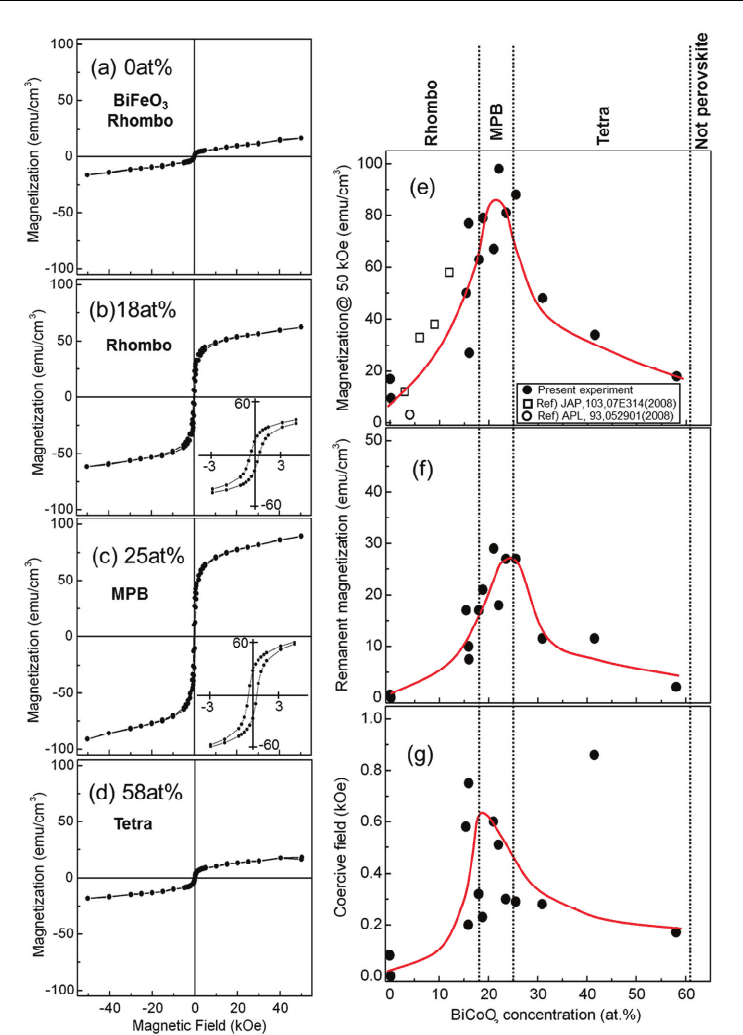
Multifunctional Characteristics of B-site Substituted BiFeO
3
Films
397
Fig. 26. M-H curves and corresponding magnetic parameters at 300 K.

Ferroelectrics – Physical Effects
398
Figure 27(a) and 27(b) show the M-H curves for 300 and 10 K for the BiFeO
3
–BiCoO
3
film
with 15 at.% of BiCoO
3
concentration. Interestingly, the slope at high magnetic field became
larger when decreased the temperature to 10 K. Figure 27(c) shows the temperature
dependence M
50kOe
, M
r
, and H
c
. M
50kOe
and M
r
increased with decreasing temperature;
however, these were not show strong temperature dependence. In contrast, H
c
clearly
increased with decreasing temperature.
Because BiFeO
3
and BiCoO
3
are synthesized under atmospheric pressure and a very high
pressure phase, respectively, it is possible that the formation of magnetic impurities such as
Co, CoFe
2
O
4
, and Fe
3
O
4
etc., may adversely affect the magnetic properties at high
concentrations of BiCoO
3
. In our previous studies, apparent magnetic impurities were not
observed in the XRD measurement; however, nanosized magnetic particles are difficult to
detect by XRD measurements. The superparamagnetic limit is a few nanometers in diameter
for Co, CoFe
2
O
4
, and Fe
3
O
4
etc. Particles with such small sizes can be detected by TEM.
Therefore, the microstructure of the film was confirmed by a cross-sectional TEM
observation for a BiCoO
3
concentration of 17 at.%. [Fig. 28] No obvious magnetic impurities
were observed in the TEM image, [Fig. 28(a)] and there was no diffraction spot attributed to
magnetic impurities in the NBD pattern. [Fig. 28(b)] Our previous studies on nanoparticles
suggest that particles that are a few nanometers in size can be confirmed by NBD, indicating
that the influence of magnetic impurities might be ignored in our discussion. Although a
further detailed investigation of the microstructure by high-resolution TEM observation is
necessary, the enhancement of the magnetic properties might be attributable to ferro-like
magnetic ordering.
Fig. 27. M-H curves for 300 (a) and 10 K (b) for the BiFeO
3
–BiCoO
3
film with 15 at.% of
BiCoO
3
concentration, and temperature dependence of magnetization at 50 kOe (M
50kOe
),
remanent magnetization (M
r
), and coercivity (H
c
) (c).
